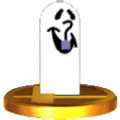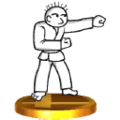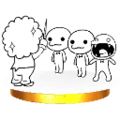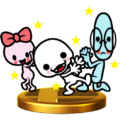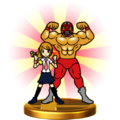Rhythm Heaven (universe)
| Rhythm Heaven (universe) Rhythm Paradise (universe) | |
|---|---|
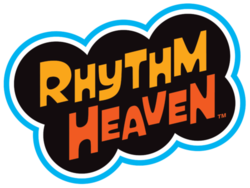
| |
| Developer(s) | Nintendo J.P ROOM Sega TNX |
| Publisher(s) | Nintendo Sega (arcade version) |
| Designer(s) | Kazuyoshi Osawa Ko Takeuchi Masami Yone Tsunku♂ |
| Genre(s) | Rhythm |
| Console/platform of origin | Game Boy Advance |
| First installment | Rhythm Tengoku (2006) |
| Latest installment | Rhythm Heaven Megamix (2015) |
| Article on Rhythm Heaven Wiki | Rhythm Heaven (universe) Rhythm Paradise (universe) |
The Rhythm Heaven universe (リズム天国, Rhythm Heaven), known as Rhythm Paradise in PAL regions, is a series of rhythm-based music games made by Nintendo SPD. The series was created and developed by the same core team that made the WarioWare series. Because of this, the two series frequently reference and cross over with each other.
Franchise Description[edit]
The series can be traced back to several different projects. Around 2002, designer Kazuyoshi Osawa created a Game Boy Advance tech demo that consists of playing a drum kit. Every button on the system corresponded with a different drum. More game modes were slowly added over the course of several years. In 2004, music producer Tsunku approached Nintendo with an unrelated pitch based around players intuitively playing a rhythm game without visual indicators.[1] The higherups were initially hesitant to approve such an experimental title out of concern of only catering to a niche audience. This project was then merged with the tech demo, and the staff were combined going forward. This worked out for everyone as the tech demo team now have clear direction and Tsunku already wanted his game to be on GBA. He also recommended the staff to take dance lessons to improve their internal rhythm and make development easier on a human level. The first Rhythm Heaven game finally released in Japan on August 3, 2006 (referred to in English as the literal translation Rhythm Tengoku to distinguish it from its sequel).
While only a modest success in terms of sales, the game was received well by critics and audiences. Particular highlights were its presentation and soundtrack courtesy of Tsunku, which inspired other companies to make similar games in the future. Staff at Sega were particularly fond of the title, and approached Nintendo on developing an arcade version for their Naomi arcade board. This arcade version released in Japan on September 20, 2007. The game received remastered graphics and audio, as well as minor gameplay tweaks to accommodate the very different controls. The game also features multiplayer, a feature that would not be introduced to the main series for many years.
A sequel was immediately put into production. However, this new project took much longer to develop then expected due to design hurdles. When the project was decided to be on the Nintendo DS, the team decided to use the touch screen as the main way to control the minigames. This thought evolved into the "Flick Action," which alone took close to a year to implement. While the team initially had trouble with making the system feel fair to the player, they all agreed it is an intuitive way to keep timing and believed it should be in the game. This title finally released in Japan on July 31, 2008 as Rhythm Heaven Gold. This game was also the first in the series to release internationally, releasing throughout 2009: it was renamed to Rhythm Heaven in the Americas and Australia, Rhythm Paradise in Europe, and Rhythm World in Korea. While there were no major gameplay differences, a significant part of the presentation was changed internationally by translating lyrics and toning down the more decidedly "Japanese" elements that other countries would not understand. The game was praised for its improvement on the first game and its innovations in the rhythm game genre.
Another sequel was greenlit, this time for Wii. While motion controls were considered, they were dropped due to their lack of precision and replaced with traditional button controls. The team also experimented with 3D models, but abandoned the idea and stuck to 2D animation which they believed flowed better. The game released in Japan on July 21, 2011 as Everyone's Rhythm Heaven. The game later released in the Americas as Rhythm Heaven Fever, in Europe and Australia as Beat The Beat: Rhythm Paradise, and in Korea as Rhythm World Wii. Aside from the regional changes from the previous game returning, English releases had a minigame based on a manzai comedy routine cut and replaced with a remastered version of the "Mr. Upbeat" minigame from Rhythm Tengoku. The game was once again praised for its significantly improved sound and visuals due to being on a home console for the first time.
Another game was developed for Nintendo 3DS, this time being a collection of popular minigames from across the series as well as a few new games. The game released on June 11, 2015 as Rhythm Heaven: The Best+. The game released internationally throughout 2016: in the Americas as Rhythm Heaven Megamix (exclusively on Nintendo eShop), in Europe and Australia as Rhythm Paradise Megamix, and in Korea as Rhythm World: The Best Plus.
During the March 27, 2025 Nintendo Direct, a brand new game in the series, titled Rhythm Heaven Groove (also known as Rhythm Paradise Groove in Europe and Australia, and Rhythm Heaven: Miracle Stars in Japan and Korea), was announced for Nintendo Switch with a 2026 release date.
In Super Smash Bros. Brawl[edit]
Rhythm Tengoku is mentioned among the titles listed in the Chronicle in Japanese versions of Brawl. However, no other content from the series is featured anywhere else in the game.
In Super Smash Bros. 4[edit]
Sneaky Spirits appear as a common enemy in Smash Run in Super Smash Bros. for Nintendo 3DS. Karate Joe and the Chorus Kids, along with the aforementioned Sneaky Spirits, appear as collectible trophies in the 3DS version, while Marshal, Cam, and Miss Ribbon and the Wrestler and Reporter appear as collectible trophies in the Wii U version.
Two songs from the series are included with the Miiverse stage in Super Smash Bros. for Wii U: Blue Birds from the Nintendo DS installment Rhythm Heaven, and Monkey Watch from the Wii installment Rhythm Heaven Fever.
Additionally, icon data for a Rhythm Heaven character appears in the data for Super Smash Bros. 4, but goes unused in the final product. The Gematsu leaks, which are commonly accepted to be a leak for an early planning stage of the game, state that this Rhythm Heaven character was to be the Chorus Kids.
In Super Smash Bros. Ultimate[edit]
Several characters from throughout the series appear in the game as spirits. The Rhythm Heaven series features the most spirits of any universe not represented by a fighter.
Music[edit]
Source Tracks[edit]
- "Blue Birds": The theme from the Blue Birds minigame sourced from Rhythm Heaven.
- "Monkey Watch": The theme of the Monkey Watch minigame from Rhythm Heaven Fever. It is technically an arrangement unique to Super Smash Bros., as the song contains clapping throughout and seamlessly loops back to the start.
- "Fruit Basket": Despite its name, this theme is sourced from the minigame Fruit Basket 2 from Rhythm Heaven Megamix.
Spirits[edit]
The following characters from the series are spirits.
Primary spirits[edit]
Support spirits[edit]
| No. | Image | Name | Class | Cost | Ability |
|---|---|---|---|---|---|
| 1,195 | Sick Beats Doctor | ★ | 1 | Critical-Health Defense ↑ | |
| 1,199 | Baxter & Forthington | ★ | 1 | Rocket Belt Equipped |
Games with elements appearing in the Super Smash Bros. series[edit]
The Rhythm Heaven universe has games represented throughout the Super Smash Bros. series with a total of 4 games. The latest game represented in this universe is Rhythm Heaven Megamix, released on June 11, 2015.
Rhythm Tengoku[edit]
- Enemy:
 Sneaky Spirit appears in Smash Run.
Sneaky Spirit appears in Smash Run.
- Trophies:
 Sneaky Spirit and Karate Joe appear as trophies.
Sneaky Spirit and Karate Joe appear as trophies.
- Spirits:
 Karate Joe, The Wandering Samurai, and Sick Beats Doctor appear as spirits.
Karate Joe, The Wandering Samurai, and Sick Beats Doctor appear as spirits.
Rhythm Heaven / Rhythm Paradise[edit]
- Trophies:
 The Chorus Kids appear as a trophy.
The Chorus Kids appear as a trophy.
- Spirits:
 The Chorus Kids and Munchy Monk appear as spirits.
The Chorus Kids and Munchy Monk appear as spirits.
- Music:
 "Blue Birds": The theme from the Blue Birds minigame sourced from this game.
"Blue Birds": The theme from the Blue Birds minigame sourced from this game.
Rhythm Heaven Fever / Beat the Beat: Rhythm Paradise[edit]
- Enemy:
- Trophies:
 Marshal, Cam, and Miss Ribbon and the Wrestler & Reporter appear as trophies.
Marshal, Cam, and Miss Ribbon and the Wrestler & Reporter appear as trophies.
- Spirits:
 Wandering Samurai (Rhythm Heaven Fever), Baxter & Forthington and Reporter & Wrestler appear as spirits.
Wandering Samurai (Rhythm Heaven Fever), Baxter & Forthington and Reporter & Wrestler appear as spirits.
- Music:
 "Monkey Watch": Theme of the Monkey Watch minigame from this game. It is technically an arrangement unique to Super Smash Bros., as the song contains clapping throughout and seamlessly loops back to the start.
"Monkey Watch": Theme of the Monkey Watch minigame from this game. It is technically an arrangement unique to Super Smash Bros., as the song contains clapping throughout and seamlessly loops back to the start.
Rhythm Heaven Megamix / Rhythm Paradise Megamix[edit]
- Spirits:
 The Sumo Brothers appear as a spirit.
The Sumo Brothers appear as a spirit. Karate Joe, The Wandering Samurai, Sick Beats Doctor, The Chorus Kids, Munchy Monk and Baxter & Forthington use artwork from this game.
Karate Joe, The Wandering Samurai, Sick Beats Doctor, The Chorus Kids, Munchy Monk and Baxter & Forthington use artwork from this game.
- Music:
 "Fruit Basket": Despite being titled Fruit Basket, the theme is actually derived from its sequel, titled Fruit Basket 2.
"Fruit Basket": Despite being titled Fruit Basket, the theme is actually derived from its sequel, titled Fruit Basket 2.
References[edit]
